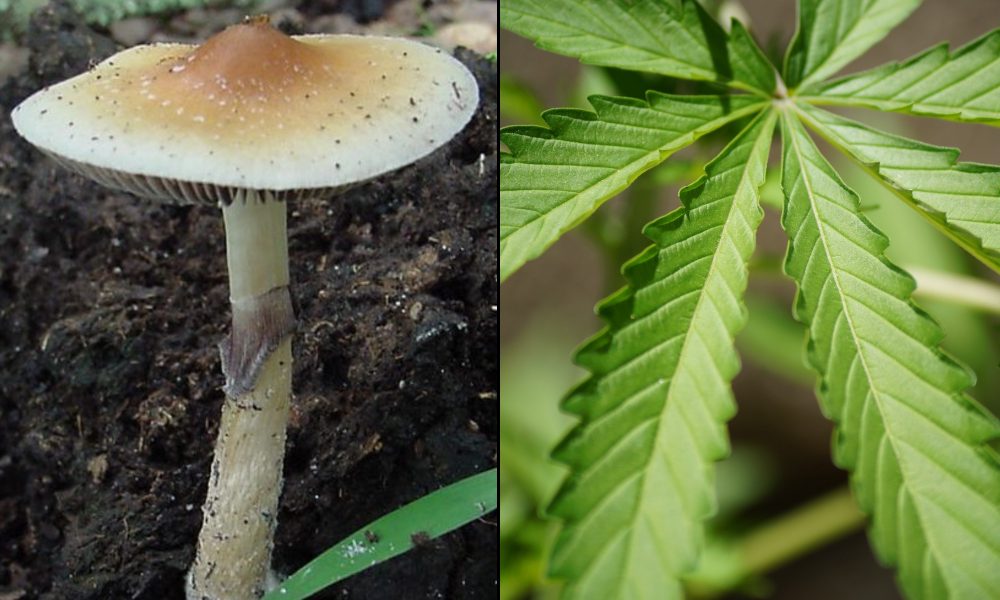The Drug Enforcement Administration (DEA) is proposing a dramatic increase in its 2023 production quotas for marijuana compounds and psychedelics like psilocybin and ibogaine to “support research and clinical trials” into the substances.
DEA wants to nearly double the amount of psilocybin, psilocyn and delta-9 THC that’s manufactured compared to initial levels set for this year, while quintupling how much ibogaine is produced. It also wants 23 times as much of “other tetrahydrocannabinol,” raising the quota from 15,000 grams to 350,000 grams for 2023.
The agency had already increased its initial quota for various controlled substances, including cannabis and psychedelics, late last year when it finalized the numbers. But now, in a notice published in the Federal Register on Tuesday, DEA said that more significant changes are warranted.
For psilocybin, the proposed new quota is 15,000 grams, rather than 8,000 grams as previously set for 2023. DEA also wants 24,000 grams of the psychedelic compound psilocyn, double its prior 12,000-gram quota.
The now-increased initial 2023 levels for both of the “magic mushroom” components already represented significant increases from those set for prior years, demonstrating the ongoing heightened level of interest in researching psychedelics over time.
DEA is also proposing to manufacture 150 grams of ibogaine—five times the amount it called for in December 2022.
While the agency didn’t change its 6.7 million-gram quota for marijuana for the year, it is now calling for the manufacturing of 628,460 grams of delta-9 THC, rather than 384,460 grams—a 63 percent increase.
For all other tetrahydrocannabinol, DEA wants 350,000 grams, a notable increase from its prior 15,000-gram quota—a massive 2,233 percent increase.
The proposed increases, which are subject to a 30-day public comment period starting on Tuesday, comes in the context of an ongoing administrative review into the scheduling status of cannabis that DEA is actively carrying after receiving a recommendation from the U.S. Department of Health and Human Services (HHS) to move marijuana from Schedule I to Schedule III under the Controlled Substances Act (CSA).
It also comes as experts await a potential federal approval for certain psychedelics like psilocybin and MDMA as therapeutics for the treatment of serious mental health conditions.
The updated quotas reflect “the estimated medical, scientific, research, and industrial needs of the U.S., for lawful export requirements, and for the establishment and maintenance of reserve stocks,” DEA said in its new quota increase notice.
“DEA is proposing increases to the [aggregate production quotas] for the following schedule I substances: all other tetrahydrocannabinol, delta-9-tetrahydrocannabinol, ibogaine, psilocybin, and psilocyn,” it said. “These proposed increases are to support research and clinical trials by DEA-registered schedule I researchers. These proposed increases demonstrate DEA’s support for research with schedule I controlled substances.”
| Substance | 2021 final | 2022 final | 2023 proposed | 2023 final | 2023 adjusted |
| All other tetrahydrocannabinol | 1,000 | 2,000 | 15,000 | 15,000 | 350,000 |
| Psilocybin | 6,000 | 8,000 | 8,000 | 8,000 | 15,000 |
| Psilocyn | 3,500 | 4,000 | 8,000 | 12,000 | 24,000 |
| Delta-9-THC | 384,460 | 384,460 | 384,460 | 384,460 | 628,460 |
| Ibogaine | 30 | 30 | 30 | 30 | 150 |
DEA’s prior “final” quotas that were published late last year already contained increases compared to its initial proposal, with the agency calling for the manufacturing of more psychedelic compounds such as MDMA, psilocyn and 5-MeO-DMT.
This year’s 6.7 million-gram quota for marijuana is more than double DEA’s final cannabis quota for 2022, which was 3.2 million grams. It was 2 million grams for 2021.
Growing millions of grams of cannabis may be easier since DEA finally authorized additional manufacturers at the beginning of the year. Those approved cultivators are now able to apply for a contract to be federal marijuana suppliers for study purposes under the National Institute on Drug Abuse (NIDA).
The agency has touted its Schedule I drug production quotas as evidence that is supports rigorous research into the substances, but it’s faced criticism from advocates and scientists over actions that are viewed as antithetical to promoting studies.
Following pushback, DEA recently retreated on a proposed ban on psychedelic compounds that scientists say have research value.
That marked another win for scientific community, coming just one month after DEA abandoned separate plans to place five tryptamine psychedelics in Schedule I.
Meanwhile, a federal appeals court recently ruled against DEA in a lawsuit over a Washington State doctor’s petition to reschedule psilocybin. The court said DEA failed to explain its reasoning when it denied the petition, and it ordered the agency to provide a more complete justification.
With respect to the agency’s marijuana scheduling review, a coalition of 31 bipartisan House lawmakers has sent a letter to DEA Administrator Anne Milgram, urging her to take into account congressional and state marijuana legalization efforts as it completes that assessment. They also criticized the limitations of simple rescheduling as they push for complete a complete removal of marijuana from the CSA.
The letter serves as a counterbalance to other recent messages DEA has received from congressional opponents of reform and former DEA and White House drug czars who argue that even moving marijuana to Schedule III would go too far.
A coalition of 14 Republican congressional lawmakers recently urged DEA to “reject” the top federal health agency’s recommendation to reschedule marijuana and instead keep it in the most restrictive category under the CSA.
Meanwhile, two GOP senators, including the lead Republican sponsor of a marijuana banking bill that cleared a key committee last month, recently filed new legislation to prevent federal agencies from rescheduling cannabis without tacit approval from Congress.
Where Presidential Candidate Dean Phillips Stands On Marijuana And Psychedelics
Image element courtesy of Kristie Gianopulos.
Read the full article here









